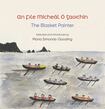
As Leaving Cert students of Irish once knew, the great storyteller Peig Sayers had 11 children, of whom six survived. The seventh, born on the Blasket Islands in 1904, was Mícheál Ó Gaoithín, a storyteller and memoirist like his mother and who was known as An File due to his skill as a poet.
Ó Gaoithín not only contributed to the extraordinary outpouring of Irish-language writing that came from the Blaskets – which included Tomás O Criomhthain’s The Islandman, and Fiche Bliain ag Fás by Muiris O Suilleabháin – he also chronicled island life in 200 paintings between 1968 and 1974, and a selection has been compiled in this elegant edition by the artist Maria Simonds-Gooding.
It was she who introduced Ó Gaoithín to painting, after a chance meeting in Baile Bhiocáire, where he and Peig had settled after leaving the Blaskets in 1942. Simonds-Gooding left paper, paints and brushes at his cottage, and on her return found he had completed his first painting – a portrait of Peig sitting by the fire in the kitchen with her cat.
Net mending
From then on Ó Gaoithín’s art documented the subsistence living of the Blaskets, as he painted scenes of night fishing, seal clubbing, cattle moving and mending of nets, and relived events such as Halloween and island funerals. There were more representations of Peig, and also of the fauna of the Blaskets, including goats and puffins. As President Michael D Higgins says in the introduction, this was “beautifully primitive artwork that celebrated a yearning for the Blaskets of his childhood”.
READ MORE
At an exhibition in Dun Chaoin school on Easter Sunday 1974 which included his work, Ó Gaoithín declared to the gathering that the Blasket Islanders were not only writers but also painters. “I was happy to share, in the moment, An File’s announcement before his own people of his new-found talent,” Simonds-Gooding writes.
Tragic twist
There was a sad end to his story. After Ó Gaoithín died unexpectedly later that year, Simonds-Gooding went to Dingle hospital to retrieve the last of his paintings, only to find the bedside locker where he’d kept them had been emptied. “The realisation that all his paintings had accidentally been thrown out was devastating,” she says. A further tragic twist is that a project on which they were working – an illustrated book Sceál an Mháirnéalaigh Bháidhte (The Story of the Drowned Sailor) – was never finished because the manuscript “was somehow mislaid in Dublin”.
In her essay for this compilation, curator and art historian Catherine Marshall debates whether Ó Gaoithín, described by those who knew him as intelligent and quiet, should be considered an “outsider” artist. It is true he had no training, never visited an art gallery, and probably had no access to books about painting. His artwork “was completely free of the influence of other artists and devoid of any commercial motives”, she writes. Yet his inner vision of life on the Blaskets connected him to a community, and therefore he was never marginalised “but became, instead, the perfect representative of a rich, shared life that has now gone forever”.












